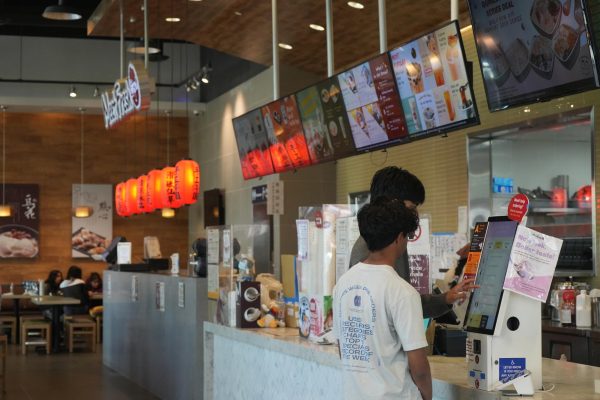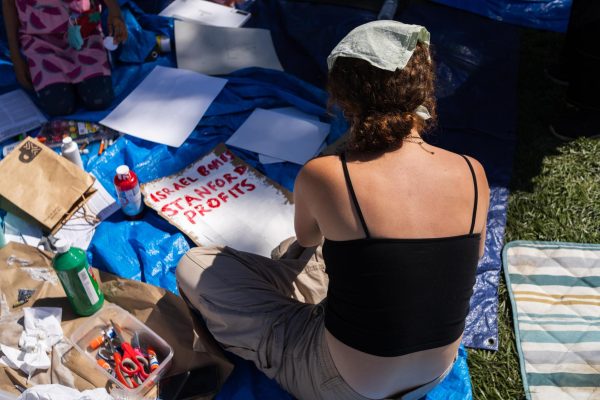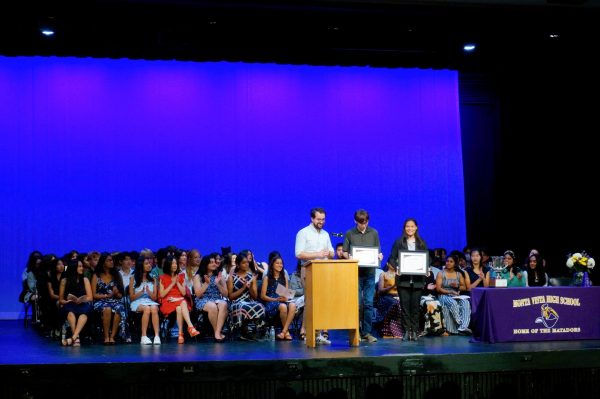COVID-19 surges for weeks following winter break
Understanding the increase in COVID-19 cases at FUHSD
On the first day of the semester, Jan. 3, FUHSD sent an email to community members that included numerous COVID-19 updates. The email began with a section titled “Increasing COVID Cases,” where it stated, “we anticipate seeing a higher number of COVID-19 positives in our district this week.”
In the first three weeks of the semester, there have been 622 students and 74 staff who have tested positive for COVID-19 across FUHSD, dwarfing numbers from before the winter break. MVHS Assistant Principal and current COVID-19 designee Sydney Fernandez attributes the sudden rise in cases to the “highly contagious” omicron variant.
With many students testing positive, questions surrounding a return to remote learning began circulating in the community. However, the decision is not up to MVHS or FUHSD administration; instead, schools are required to stay open until Santa Clara County declares otherwise. Assistant Principal and former COVID-19 designee Janice Chen asserts that “we can’t do remote learning.”
“Santa Clara County is pushing schools not to go remote because it’s not good for kids,” Chen said. “That’s what they’re focusing on. If you can be in-person, it is best for students to be learning in-person, and that’s the guidance from the county, and that’s why we’re not going to remote learning.”
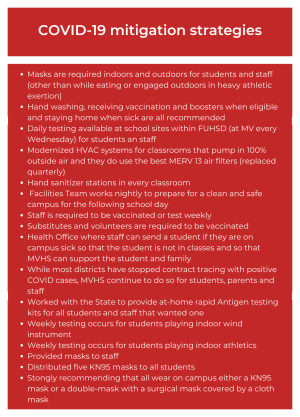
Journalism teacher Julia Satterthwaite, agrees with the county’s decision to keep schools open and believes that it is worth the risk, particularly with regards to the mental health of students.
“Research and experience have shown that it is better for kids to be at school in-person in terms of their mental health and social-emotional wellbeing even if they are at risk of getting COVID-19,” Satterthwaite said. “Ultimately, that risk is worth it, compared to what we saw during the quarantine when everyone was at home [and] there were extreme levels of depression and suicide rates jumped.”
With MVHS continuing to operate in-person, students who test positive have their learning impacted as they have to quarantine for a minimum of five days, and can only return after their symptoms resolve and they have a negative antigen test result. Chen acknowledges student and parent concerns of COVID-19 hampering academic success but insists there will be “no negative impact” on grades if a student tests positive.
“Your health comes first,” Chen said. “Stay home, take care of your health, rest and teachers will be flexible. You’ll have ample time to make up any missing work or assignments without penalty when you are ready to come back to school.”
In terms of students who are stuck in foreign countries because of the pandemic, whether because of flight cancellation, travel restrictions or a positive test, Fernandez states that MVHS is “in contact with them and have asked that they work with teachers to get any work that they are able to do while they’re gone.”

To help combat the surge, FUHSD distributed at-home COVID-19 tests on Jan. 4, the tests helped identify more positive cases and slow the spread of the virus. Fernandez hopes students and staff who receive a positive result can “stay home and take care of themselves to get healthy and hopefully reduce some of the spread that is happening.”
In addition to the at-home tests, weekly testing is available at all five FUHSD sites: Mondays at LHS, Tuesdays at HHS, Wednesdays at MVHS, Thursdays at CHS and Fridays at FHS. Chen is grateful for the accessibility of tests and recommends that anyone who thinks they might have COVID-19 get tested.
“We are super fortunate in our district, our students and our staff members because we have availability to test every single day of the week,” Chen said. “Any day of the week, our students and families can go get tested, you get the results in 30 minutes between 7:30 a.m. and 4 p.m. So we’re very lucky because it’s very difficult to get tested. For us to be able to do that for all of our students is amazing.”
Satterthwaite utilizes on-campus testing every Wednesday even though she is double vaccinated and boosted. On Thursday, Jan. 13, she received a positive test result via email while teaching her second period Yearbook class. After processing the email, Satterthwaite contacted Chen and left campus.
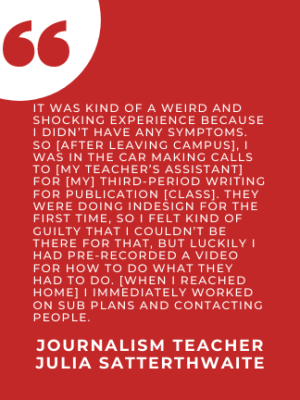
“It was kind of a weird and shocking experience because I didn’t have any symptoms. So [after leaving campus], I was in the car making calls to [my teacher’s assistant] for [my] third-period Writing for Publication [class],” Satterthwaite said. “They were doing InDesign for the first time, so I felt kind of guilty that I couldn’t be there for that, but luckily I had pre-recorded a video for how to do what they had to do. [When I reached home] I immediately worked on sub plans and contacting people.“
Despite the sudden, unexpected result, Satterthwaite was able to manage the two and a half school days she missed, helped by the fact her classes were either mostly student-run or had teaching assistants and one of her recovery days fell on the Martin Luther King holiday.
Although Satterthwaite was able to get substitutes, the school is experiencing a substitute teacher shortage. Chen says the shortage is linked with COVID-19 and finds the shortage to be a “struggle.”
“We’ve had to ask other teachers to cover classes if they’re willing to,” Chen said. “Obviously, it’s voluntary. We’ve had administrators go to cover classes as well. With people being out, it is a challenge getting subs right now.”
Even with all the obstacles associated with the surge in cases, Chen emphasizes that MVHS is doing a good job containing the virus compared to nearby schools.
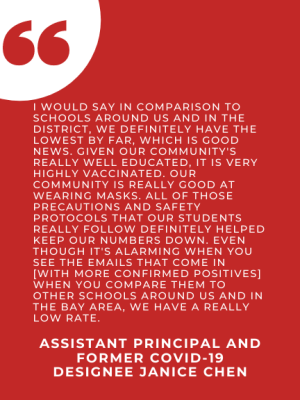
“I would say in comparison to schools around us and in the district, we definitely have the lowest by far, which is good news,” Chen said. “Given our community’s really well educated, it is very highly vaccinated. Our community is really good at wearing masks. All of those precautions and safety protocols that our students really follow definitely helped keep our numbers down. Even though it’s alarming when you see the emails that come in [with more confirmed positives] when you compare them to other schools around us and in the Bay Area, we have a really low rate.”
Chen expects the peak of the omicron surge to be at the end of January and then expects cases to “plateau and slow down” in February. Positive results are declining in the county, corroborated by a decline of COVID-19 RNA in wastewater.
Satterthwaite is sanguine about future COVID-19 outbreaks and is optimistic that we are reaching closer to the end of what seems to be living in a state of a neverending pandemic.
“We’ve already had two years of limited social interaction,” Satterthwaite said. “I think particularly because every strand of COVID-19 from this point forward, hopefully, becomes less severe, we’ll reach a point where we can live our normal lives.”
Click here to see how the pandemic has changed in the county since the start of the pandemic. For more information about COVID-19 protocols and cases go to the Santa Clara County COVID-19 website.







